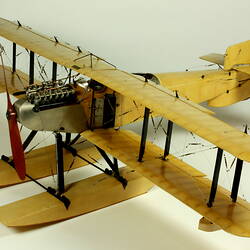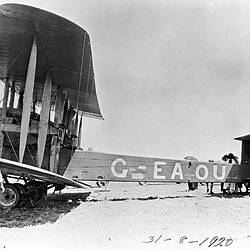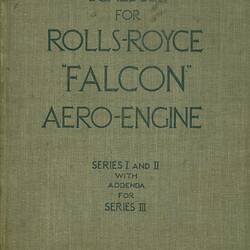The Eagle was the first aero engine designed by Rolls-Royce. The design team was led by Henry Royce along with his principal design assistant Albert Elliot, and a talented works engineer, Maurice Olley. The team worked from Royce's home at St Margaret's Bay in Kent due to Royce's ill health. Royce used the 40/50 h.p Silver Ghost engine as the basic platform for the new V12 which was intended to provide a powerful and reliable liquid-cooled military aero engine which was not available in the UK at the outbreak of the First World War in August 1914. Rolls-Royce produced a small batch of French Renault V8 aero engines on the condition that this would be a trial project for the new engine.
The prototype Eagle engine was ready for testing at Rolls-Royce's Derby works in February 1915. The design process was complicated by the locations of the design team and the factory being 200 miles apart. Drawings and wooden patterns were sent backwards and forwards until Royce was satisfied and drawings were prepared for around 2,000 components. The Eagle featured forged aluminium pistons and pressed steel water jackets to save weight. Power output exceeded the target of 200 b.h.p and was soon increased to 300 b.h.p at 2000 r.p.m. The first air test took place on 18 December 1915 when a twin-engine Handley Page O/100 bomber took off from Hendon near London.
The Eagle was progressively developed but retained a capacity of 20.32 litres. The Eagle VIII (350 b.h.p) was the most widely used version being installed in aeroplanes including Airco DH4, the Handley Page 0/100, O/400 and V/1500 series and the Vickers Vimy bomber which was used in 1919-20 to complete the first crossing of the Atlantic Ocean by J. Alcock & A.W Brown, the first flight from England to Australia by Ross & Keith Smith, Bennett & Shiers in Vimy G-EAOU and the first England to South Africa flight by Van Ryneveld & Brand. In Australia, the Eagle VIII was fitted to the Fairey IIID seaplane used by the RAAF in the 1920s. A Fairey IIID flown by Goble & McIntyre completed the first circumnavigation of Australia in 1924.
More Information
-
Keywords
-
Localities
-
Authors
-
Article types








